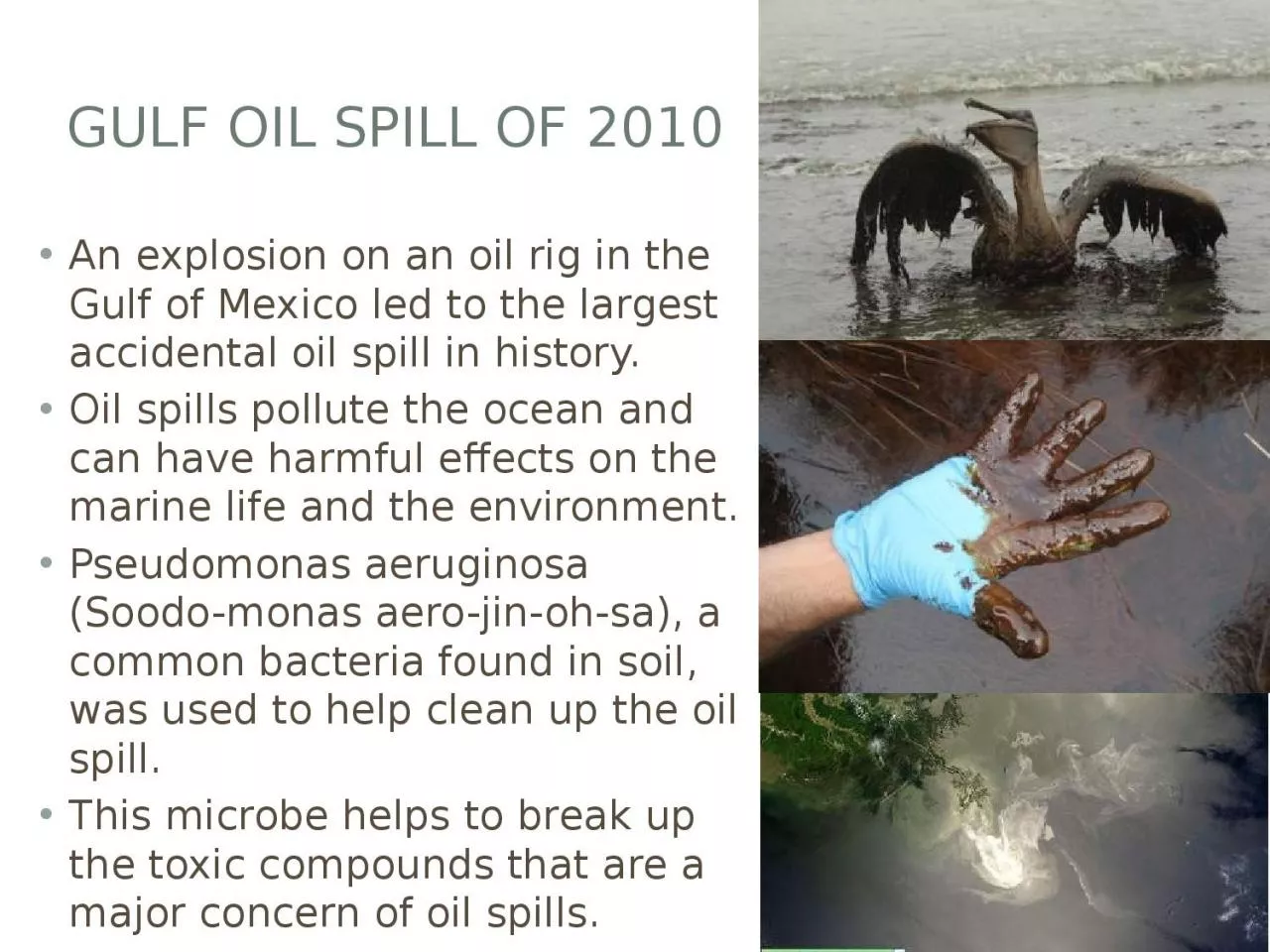

Oil spills pollute the ocean and can have harmful effects on the marine life and the environment Pseudomonas aeruginosa Soodo monas aero jin oh sa a common bacteria found in soil was used to help clean up the oil spill ID: 1012361
Download Presentation The PPT/PDF document "Gulf oil spill of 2010 An explosion on a..." is the property of its rightful owner. Permission is granted to download and print the materials on this web site for personal, non-commercial use only, and to display it on your personal computer provided you do not modify the materials and that you retain all copyright notices contained in the materials. By downloading content from our website, you accept the terms of this agreement.
1. Gulf oil spill of 2010An explosion on an oil rig in the Gulf of Mexico led to the largest accidental oil spill in history.Oil spills pollute the ocean and can have harmful effects on the marine life and the environment.Pseudomonas aeruginosa (Soodo-monas aero-jin-oh-sa), a common bacteria found in soil, was used to help clean up the oil spill.This microbe helps to break up the toxic compounds that are a major concern of oil spills.
2. AND THEIR ROLESOIL MICROBES
3. WHAT ARE SOIL MICROBES?Microbes are tiny microscopic organisms.Microbes that live in the soil include:BacteriaProtozoaNematodesThere are many different ways that soil microbes help plants.A single tablespoon of healthy soil might contain over a billion beneficial soil microbes.Microscopic means that the organisms are so small that they can only be seen with a microscope.
4. DecomposersSoil Microbes are decomposers.Decomposers consume dead plants and animals and recycle the nutrients back to plants.Decomposers include fungi, worms, bacteria, nematodes, and protozoa.
5. Recycling of nutrientsPlants dieSoil Microbes break down the dead materialThe nutrients from the broken down material help other plants grow.
6. Nutrients recycled by soil microbes
7. What does “organic” mean?Organic Compounds – compounds that contain carbon, and other elements such as hydrogen, oxygen, phosphorus, nitrogen, and sulfurOrganic Matter – Contains carbonDerived from living thingsMaterial in the process of decaying or decomposingExamples: dead leaves, plant trimmings, manure, wood, dead animalsDecomposition of organic matter would take a lot longer on earth if there were not any soil microbes.
8. BacteriaThe most numerous type of soil organismMake nutrients available to plants
9. bacteriaBreak down minerals in the soil to release nutrients such as nitrogen, sulfur, phosphorus, potassium, calcium, magnesium, and ironMake and release plant growth hormonesIncrease solubility of nutrients. Nutrients must be dissolved in the soil before plants can use themImprove soil structureFight root diseasesDetoxify soilTransform nitrogen gas in the air to a form plants can use, and then back into a gas
10. Nitrogen fixationThis process of transforming nitrogen into a form plants can use is known as nitrogen fixation.
11. protozoaPredatory, meaning protozoa eat other microbesWhen protozoa eat bacteria, they speed up the cycling of nitrogen, making nitrogen more available to plants
12. nematodesA few species are harmful to plants, but these are kept in check by predatory nematodes and arthropods.The harmless nematodes eat decaying plants, soil microbes and other nematodes and release nutrients from the bodies of their prey.This speeds up nutrient recycling.
13. fungiRelease nutrients from soil mineralsProduce plant hormonesHelp trap nematodes that are harmful to plantsMycorrhizae – live in or on plant rootsIncrease uptake of water and nutrients by roots.Produce hormones and antibiotics that help plant growth and prevent diseases.The fungi benefits by taking in the nutrients from the roots they live in.
14. Soil microbes are an important part of the soil food chain.The arrows in this food web represent the flow of energy from one organism to another.When one organism eats another, it gains energy from that organism.
15. CompostingCompost is used as a fertilizer and soil amendment.Leaves, grass, twigs, and organic food scraps decompose over time to form humus, a rich, dark brown soil-like material that is rich in nutrients.
16. It’s good for your garden!Reduces fertilizer applicationDecreases the amount of waste sent to landfillsWhy compost?